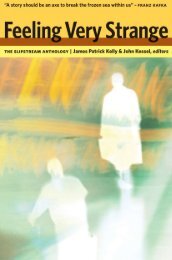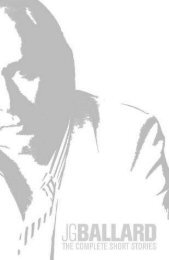The Curse of the Wer.. - Site de Thomas - Free
The Curse of the Wer.. - Site de Thomas - Free
The Curse of the Wer.. - Site de Thomas - Free
You also want an ePaper? Increase the reach of your titles
YUMPU automatically turns print PDFs into web optimized ePapers that Google loves.
106 THE CURSE OF THE WEREWOLF<br />
a quite sensitive human being who, one might say, disguises himself<br />
as a dog in or<strong>de</strong>r to liberate his Nietzschean potential from emasculating<br />
domesticity.’ 39 In this story, <strong>the</strong> ‘call to become-wolf’ prevails; in<br />
<strong>the</strong> o<strong>the</strong>r, <strong>the</strong> ‘beast within’ is successfully tamed and subjugated. By<br />
separating <strong>the</strong> masculine project <strong>of</strong> repressing <strong>the</strong> ‘beast within’ from<br />
<strong>the</strong> project <strong>of</strong> ‘becoming-wolf’ in this fashion, London’s novels draw<br />
attention to a tension that has remained <strong>de</strong>eply embed<strong>de</strong>d in Western<br />
narratives <strong>of</strong> masculinity.<br />
<strong>The</strong> ‘call to become-wolf’ was exemplified in <strong>the</strong> twentieth century<br />
through <strong>the</strong> Nazi cult <strong>of</strong> masculinity. As <strong>The</strong>weleit’s survey <strong>of</strong><br />
<strong>the</strong> narratives and metaphors generated by and for German soldiers<br />
<strong>de</strong>monstrates, <strong>the</strong> icon <strong>of</strong> <strong>the</strong> beast <strong>of</strong> prey (most frequently <strong>the</strong> wolf)<br />
recurs repeatedly in <strong>the</strong> literature <strong>of</strong> <strong>the</strong> movement. <strong>The</strong> following<br />
passage, from a Freikorps novel <strong>of</strong> 1932, is typical. Two women ‘in<br />
heavy sheepskins’ have preten<strong>de</strong>d to be Freikorps collaborators, but <strong>the</strong><br />
soldiers have just discovered <strong>the</strong>ir brethren, mutilated in <strong>the</strong> women’s<br />
cellar.<br />
[A] single, piercing howl erupts from <strong>the</strong> lips <strong>of</strong> <strong>the</strong> men who are standing<br />
amid <strong>the</strong> corpses. An elemental sound from <strong>the</strong> <strong>de</strong>epest <strong>de</strong>pths <strong>of</strong> nature,<br />
its roar expunges all trace <strong>of</strong> humanity from <strong>the</strong> human body. It wakes<br />
<strong>the</strong> beast and sets it on <strong>the</strong> blood trail. Overcome by a common resolve,<br />
two or three men storm upstairs. <strong>The</strong> dull thudding <strong>of</strong> clubs is heard.<br />
Both women lie <strong>de</strong>ad on <strong>the</strong> floor <strong>of</strong> <strong>the</strong> room, <strong>the</strong>ir blood exactly <strong>the</strong><br />
same colour as <strong>the</strong> roses blooming in extravagant pr<strong>of</strong>usion outsi<strong>de</strong> <strong>the</strong><br />
window. 40<br />
As <strong>The</strong>weleit points out, ‘It’s important to note that <strong>the</strong> mur<strong>de</strong>rous<br />
beast is presented positively. Only women, <strong>the</strong>n, are not permitted<br />
to become “animals”: man may (and should?) do so. <strong>The</strong> involuntary<br />
nature <strong>of</strong> <strong>the</strong>ir <strong>de</strong>ed is expressly applau<strong>de</strong>d.’ 41 Certainly, <strong>the</strong> image <strong>of</strong><br />
<strong>the</strong> werewolf was an object <strong>of</strong> positive i<strong>de</strong>ntification for <strong>the</strong>se men,<br />
as ano<strong>the</strong>r Freikorps novel <strong>of</strong> 1931 entitled We <strong>Wer</strong>ewolves makes<br />
perfectly clear.<br />
While narratives such as Frank Norris’s Vandover and <strong>the</strong> Brute<br />
(1904) and Guy Endore’s <strong>The</strong> <strong>Wer</strong>ewolf <strong>of</strong> Paris (1934) had explored<br />
<strong>the</strong> temptations <strong>of</strong> lycanthropy from <strong>the</strong> protagonists’ point <strong>of</strong> view,





